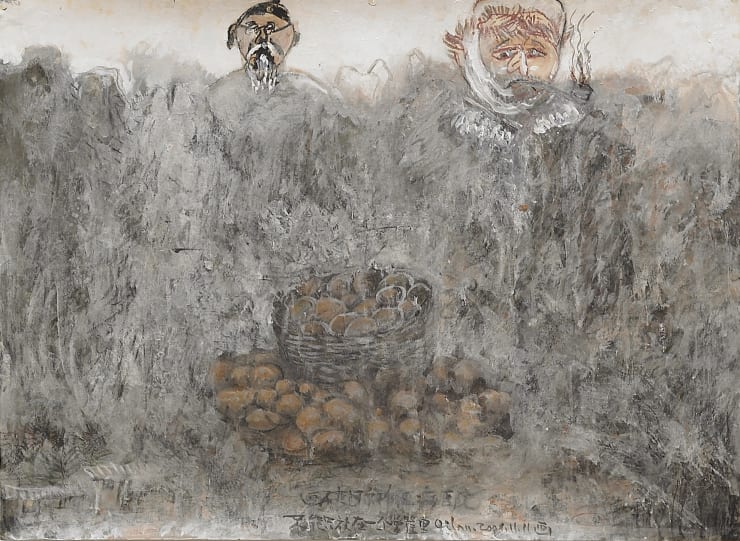Bye, Mr. Dong Qichang: Qi Lan Solo Exhibition
Bye, Mr. Dong Qichang—Qi Lan Solo Exhibition
By the end of 2013, A Thousand Plateaus Art Space is honored to present “Bye, Mr. Dong Qichang—Qi Lan Solo Exhibition”.
Qi Lan was born in Anyue County, Sichuan Province in 1973. In 1996, he graduated with a Bachelor’s Degree in the major of Chinese Traditional Painting from the Academy of Fine Arts at Southwest Normal University. In 2001, he graduated from the Department of Chinese Traditional Painting at Nanjing Arts Institute, with a Master of Arts Degree. In 2007, he began to study with Professor Wang Mengqi as a Ph.D. candidate in Fine Arts. Currently he is living and working in Shanghai as an editor of Art China.
Qi Lan has gone through the cyclic identity changes from an artist to a journalist, to a critic, and then back to an artist again. Many of his works are related to his readings. Through fragmented and selected readings, he draws inspirations in communicating and even arguing with the classical cases and works in art history. Although having received a long-term regular training in Chinese traditional painting, Qi Lan consciously keeps a distance from traditional painting in his creation, and even despises the mild traditional aesthetics and the introverted cultural character. He argues that, for a contemporary artist, a fresh aesthetic temperament and character are even more significant than the artistic language and form—“one must stand off, get weaned, find something in the wild, and start anew.” “Adventure”, as he perceives, is “the first true meaning” of culture and art, and he believes that “only when a person’s thinking and practice point to the unknown, can the unknown go toward him and unveil the totally unfamiliar and new visual experience before him, which gives him the reason to move forward.”
As a person born in the 1970s and a scholar, Qi Lan has penetrating insights into the modern and contemporary society and its culture. Fostered in the remaining climate of local gentries, he has been enlightened to take the classical approach to knowledge instead of the programmed post-modern approach. In Qi Lan’s understanding, the artist’s characters which are expressed in the art works are of great importance. Even though he sometimes works as an art critic, he never dwells on the so-called necessary logic of artistic history. He maintains that artists should ignore and even transcend the theoretical network. Hence, he is an absolute artist rather than a critic and scholar. Qi Lan’s works reflect the duality and conflict in his disposition. He was once a pure traditionalist—for more than ten years he has been immersed in the genteel Chinese literati tradition and accompanied by Ni Yunlin, Xu Wei, Dong Qichang and Ba Da Shan Ren. But Qi Lan is a contradiction with deep-concealing wild temperament, and he is never an easily tamed person by nature. Exposed to the contemporary cultural context of sudden transformations and disintegrations, he fights against and contradicts himself. His pure artistic pursuit and strong self-consciousness intensifies his denials to the extent that he would rather be squeezed to the margin and bear the dual pressure from history and reality. The early traditional Chinese paintings by Qi Lan resemble the brushstroke of Ba Da Shan Ren and Shi Tao. Whereas his oil paintings feed more or less on the techniques of modern artists, such as that of Giacometti, which places deconstruction over construction in dealing with images. What he depicts most is the pastoral landscape in traditional Chinese paintings. Therefore the juxtaposition of modern techniques and classical objects brings about the tension between deconstruction and anti-deconstruction. It has explicitly unveiled Qi Lan’s attempt for a new possibility in the collision between form and content. However, because of the ambiguous essence of his subjects and his unrealistic tendency in regard to his creation purpose, his art works refuse any textual interpretation, and fend off the logical rhetoric by creating ambiguities, seeking great spiritual elevation from the blanks of logical cracks. (selected from He Gong’s review article Concerning Qi Lan)
再见!董其昌——漆澜个展
漆澜,1973年生于四川安岳。1996年毕业于重庆西南师范大学美术学院中国画专业,获文学学士学位;2001年毕业于南京艺术学院美术学院中国画系,获文学硕士学位;2007年师从王孟奇教授攻读美术学博士学位。现为《艺术当代》杂志策划,生活、工作于上海。
漆澜经历了从画家到媒体人、批评家,再到画家的身份循环转变。他的很多作品都和阅读有关,通过片段式的、选择性的阅读,与那些经典的历史案例和作品进行交流甚至抗辩,以汲取灵感。虽然曾接受长期的中国传统山水绘画的科班教育,漆澜却坚持在创作中对传统绘画保持警惕的距离,甚至对温和的传统美学趣味和内向的文化性格报以接近歧视的态度。他认为,作为当代艺术家,新的美学气质和性格甚至比艺术语言和形态更为重要——“必须疏离,断奶,去野生找吃的,重头开始”。他将“冒险”视为文化艺术的“第一真义”,认为“只有当你的实践和思考指向未知,未知才会向你走来,一种陌生、全新的视觉形态和表现经验在你面前渐次显影,给予我继续向前的理由。”
作为70年代生人、作为学者,他(漆澜)对于现当代社会及其文化有自己精辟的理解,而有乡土士绅余温的生长氛围培育了他对智识的经典选择而不是后现代程序化处理。漆澜很注重艺术家自身性格气质在其作品中的作用,即便他有时身处评论家的位置时,也并不纠结于所谓艺术史必然的逻辑关系,而认为艺术家应该无视乃至超越理论规则,因此在个人气质上,他是彻底的艺术家,而非评论家或者学者。漆澜的作品,也体现了他气质上的双重性和冲突性。他曾经是一个纯粹的传统主义者,——曾长达到十余年沉浸于温情脉脉的文人传统之中,与倪云林、徐渭、董其昌、八大结伴而行;但是,漆澜更是一个深藏野生性的矛盾体,他的本质绝非温驯。他在当代突变和分裂的文化情景中,自我抗辩、自相冲突,纯粹的艺术情怀和任性的自我意识,强化了他的拒绝性,宁愿将自身挤压在边缘,承受着来自历史和现实的双重压力。漆澜的早期国画,笔意上很有八大、石涛的意味,油画中则多少吸收了现代主义艺术家(诸如贾科梅蒂等)的处理方式,即对于意象的处理,消解多于建构。但他描绘的对象却多是中国传统绘画中的山水田园,因此在古典对象与现代的表现方式之间,必然会出现消解与反消解的张力。漆澜想要在这种形式以及内涵的彼此碰撞中谋求一种新的可能性的意图,则确实清晰的显露出来。但又因为他所针对对象的模糊本质,以及他创作意图的非现实性,也使得他的作品抗拒任何文本意义上的解读,从而以沌淆抵御逻辑性修辞,并在逻辑破裂的空白中,寻求精神的飞跃性提升。(摘自何工《关于漆澜》)













